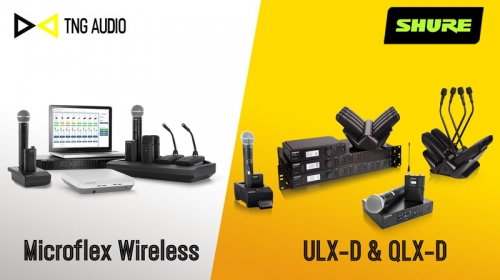So sánh các hệ thống micro không dây Shure Microflex Wireless và ULX-D/ QLX-D

Cả ba hệ thống micro không dây Shure Microflex Wireless (MXW), ULX-D và QLX-D đều sở hữu những tính năng mạnh mẽ, phù hợp với rất nhiều ứng dụng. Tuy nhiên, vì các hệ thống này khác biệt đáng kể, nên tuỳ ứng dụng cụ thể mà có hệ thống nào đó sẽ phù hợp hơn. Trong bài viết này, chúng tôi sẽ thảo luận về một số điểm giống và khác của ULX-D và MXW.
1. Đặc điểm chung:

ULX-D và MXW có các bộ phát sóng không dây boundary và cổ ngỗng dùng cho hệ thống âm thanh hội thảo
- Âm thanh Dante: Cả MXW và ULX-D đều cung cấp đầu ra âm thanh Dante. Với ULX-D, bạn sẽ cần bộ thu ULXD4D hoặc ULXD4Q. Tất cả các mẫu MXWAPT của hệ thống micro không dây MXW đều có đầu ra âm thanh Dante. QLX-D không cung cấp Đầu ra Dante.
- Nhiều kiểu dáng micro không dây: Hệ thống micro không dây MXW và ULX-D đều có bộ phát sóng không dây boundary và cổ ngỗng dùng cho hệ thống âm thanh hội thảo (tùy chọn) bên cạnh bộ phát bodypack, và micro không dây cầm tay. Trong khi đó, QLX-D chỉ có bộ phát sóng không dây cầm tay và bodypack.
- Màu sắc: Cả hai hệ thống micro không dây MXW và ULX-D đều các tùy chọn màu đen hoặc trắng với micro boundary không dây và đế mic cổ ngỗng không dây.
- Pin sạc: Tất cả các hệ thống này sử dụng được pin sạc (tiêu chuẩn trên MXW, tùy chọn trên ULX-D).
- Micro tương thích: Tất cả 3 hệ thống trên đều tương thích với rất nhiều micro Shure, trong đó có cả micro cầm tay nổi tiếng SM58 và Beta 58A cũng như hầu hết các micro đeo tai và micro cài áo Shure.
- Quản lý từ xa: Tất cả các hệ thống này có thể được quản lý từ xa bằng Microflex Wireless Software (MXW) hoặc Wireless Workbench 6 (ULX-D và QLX-D).
- Giao diện logic: Tất cả các hệ thống này có thể cung cấp thông tin cho hệ thống điều khiển của bên thứ ba thông qua giao diện Chuỗi lệnh.
2. Các tính năng độc quyền của ULX-D và QLX-D

Hệ thống micro không dây QLX-D và ULX-D bổ sung cho nhau trên các sân khấu cao cấp
- Độ trễ và tần số đáp ứng: ULX-D và QLX-D cung cấp độ trễ đầu cuối thấp tới 3 ms và đáp ứng tần số âm thanh đầy đủ từ 20 Hz - 20 kHz. MXW cung cấp độ trễ thấp tới 20 ms và đáp ứng tần số được thiết kế phù hợp cho các ứng dụng âm thanh phòng họp.
- Dải tần số RF: ULX-D và QLX-D cung cấp các hệ thống hoạt động ở nhiều dải băng tần khác nhau (tùy thuộc vào vùng).
- Đầu vào ăng-ten từ xa: ULX-D và QLX-D hỗ trợ kết nối các hệ thống ăng-ten từ xa được thiết kế tùy chỉnh bao gồm nhiều vùng.
- Receiver gắn tủ rack: Bộ thu của các hệ thống micro không dây ULX-D và QLX-D được gắn trên rack, trong khi MXWAPT được thiết kế để gắn trên tường.
- Đầu ra âm thanh Analog và Dante: ULX-D tích hợp cả đầu ra âm thanh Analog và Dante, trong khi MXW yêu cầu MXWANI4 hoặc MXWANI8 tùy chọn để cung cấp đầu ra âm thanh analog. QLX-D chỉ cung cấp đầu ra analog.
- Pin kiềm: Các bộ phát sóng của QLX-D và ULX-D có thể dùng pin AA hoặc pin sạc Shure. Trong khi đó MXW chỉ dùng pin sạc tích hợp.
- Khả năng tương thích chéo giữa QLX-D và ULX-D: Các thiết bị của ULX-D thường tương thích chéo với QLX-D và ngược lại. Để biết chi tiết, vui lòng xem: Bộ phát QLX-D có sử dụng được với bộ thu ULX-D và ngược lại không?
3. Các tính năng độc đáo của Microflex Wireless

Microflex Wireless là giải pháp âm thanh phòng họp không dây tuyệt vời
- Access point PoE tất cả trong một: Thiết bị thu phát không dây MXWAPT của hệ thống MXW có thể gắn trên tường hoặc trần và có đầy đủ các tính năng của các bộ thu rồi. Bạn sẽ không cần tủ rack hoặc cáp ăng-ten đồng trục - chỉ cần một cáp Ethernet tiêu chuẩn và một switch có cổng PoE.
- Hoạt động ở băng tần DECT 1,8/1,9 GHz không cần giấy phép: Microflex Wireless sử dụng băng tần DECT không cần cấp phép, nên không bị nhiễu từ các đài truyền hình địa phương hoặc Wi-Fi.
- Đèn LED có thể điều chỉnh: Đèn trên máy phát sóng không dây của MXW có thể được điều khiển bởi hệ thống điều khiển bên ngoài. Điều này là không thể với ULX-D vì các transmitter của nó không giao tiếp hai chiều với receiver.
- Thiết kế bộ sạc độc đáo: Các trạm sạc 4 kênh MXWNCS4 và 8 kênh MXWNCS8 tương thích với tất cả các bộ phát sóng không dây của MXW. Micro cầm tay và bodypack của ULX-D sử dụng bộ sạc khác với bộ phát không dây boundary và cổ ngỗng của nó.
- Khả năng tương thích giữa các sản phẩm: Các thiết bị của MXW không tương thích với các thiết bị của hệ thống không dây ULX-D hoặc QLX-D và ngược lại. Ví dụ: bạn không thể sử dụng ULXD1 với MXWAPT.
Shure

